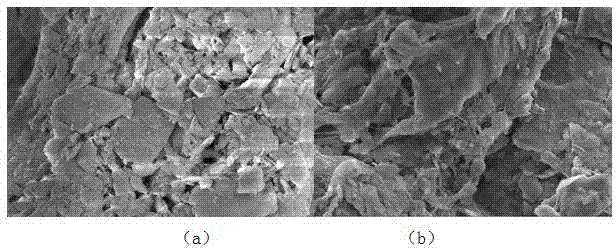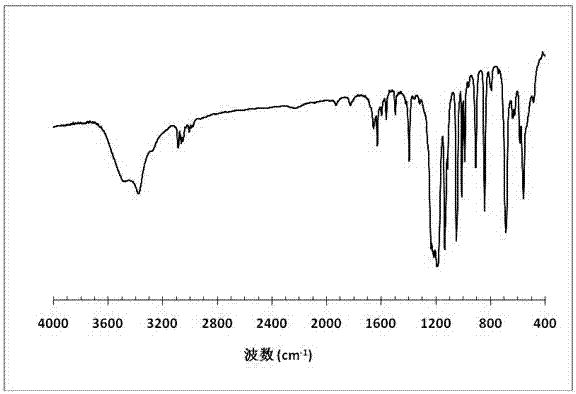Loess particle grafted copolymer adsorbent and preparation method thereof
A graft copolymer and adsorbent technology, applied in the field of loess-based adsorbents, can solve the problems of expensive, limited application, and secondary pollutants, and achieve no secondary pollution, good biocompatibility, and good adsorption performance Effect
- Summary
- Abstract
- Description
- Claims
- Application Information
AI Technical Summary
Problems solved by technology
Method used
Image
Examples
Embodiment 1
[0036] (1) Acidification of loess particles: Take a certain amount of loess particles, disperse them into HCl solution with a concentration of 5 mol / L, stir at 65°C for 3 hours, cool, filter, wash with distilled water until neutral, and dry in vacuum at 60°C for 12 hours, the acidified loess is obtained.
[0037] (2) Surface modification of loess particles: Take 1 g of acidified loess particles, disperse them in 10 mL of anhydrous ethanol-water (volume ratio of ethanol to water: 3:1), and stir for 30 minutes at room temperature; Adjust the pH of the system to 2.0 with glacial acetic acid, then add 0.5 g of KH-570, and stir for 30 minutes; then adjust the pH of the system to 9.0 with ammonia water, raise the temperature to 60°C, and stir for 5 hours to complete the reaction. The product is filtered and washed with ethanol Three times, vacuum drying at 60° C. for 5 hours to obtain surface-modified loess particles.
[0038] (3) Preparation of graft copolymer: 1 g of surface-modifi...
Embodiment 2
[0041] (1) Acidification of loess particles: Take a certain amount of loess particles, disperse them into HCl solution with a concentration of 3 mol / L, stir at 50°C for 5 hours, cool, filter, wash with distilled water until neutral, and dry in vacuum at 50°C for 24 hours. hours, the acidified loess is obtained.
[0042] (2) Surface modification of loess particles: Take 10 g of acidified loess particles, disperse them in 100 mL of ethanol-water (4:1 volume ratio of ethanol to water) mixed solution, stir and disperse at room temperature for 30 minutes; Adjust the pH of the system to 3.5, add 2.0 g KH-171, and stir for 30 minutes; then adjust the pH of the system to 10 with ammonia water, raise the temperature to 85°C, and stir for 3 hours to complete the reaction. Dry under vacuum for 3 hours to obtain surface-modified loess particles.
[0043] (3) Preparation of graft copolymer: Add 2.5 g of surface-modified loess particles to 30 mL of 1,4-dioxane, stir well at room temperatur...
Embodiment 3
[0046] (1) Acidification of loess particles: Take a certain amount of loess particles, disperse them into HCl solution with a concentration of 1 mol / L, stir at 80°C for 1 hour, cool, filter, wash with distilled water until neutral, and dry in vacuum at 60°C for 36 hours, the acidified loess is obtained.
[0047] (2) Surface modification of loess particles: Take 15 g of acidified loess particles, disperse them in 150 mL of ethanol-water (volume ratio of ethanol to water: 5:1), and stir for 30 minutes at room temperature. Adjust the pH of the system to 5.0 with glacial acetic acid, add 5.0 g of KH-171, and stir for 40 minutes. Then the pH of the system was adjusted to 11.0 with ammonia water, the temperature was raised to 60°C, and the reaction was fully stirred for 5 hours to complete the reaction. The product was suction filtered, washed with ethanol three times, and vacuum-dried at 30°C for 5 hours to obtain surface-modified loess particles.
[0048] (3) Preparation of graft...
PUM
| Property | Measurement | Unit |
|---|---|---|
| adsorption capacity | aaaaa | aaaaa |
| adsorption capacity | aaaaa | aaaaa |
| adsorption capacity | aaaaa | aaaaa |
Abstract
Description
Claims
Application Information
 Login to View More
Login to View More - R&D
- Intellectual Property
- Life Sciences
- Materials
- Tech Scout
- Unparalleled Data Quality
- Higher Quality Content
- 60% Fewer Hallucinations
Browse by: Latest US Patents, China's latest patents, Technical Efficacy Thesaurus, Application Domain, Technology Topic, Popular Technical Reports.
© 2025 PatSnap. All rights reserved.Legal|Privacy policy|Modern Slavery Act Transparency Statement|Sitemap|About US| Contact US: help@patsnap.com



